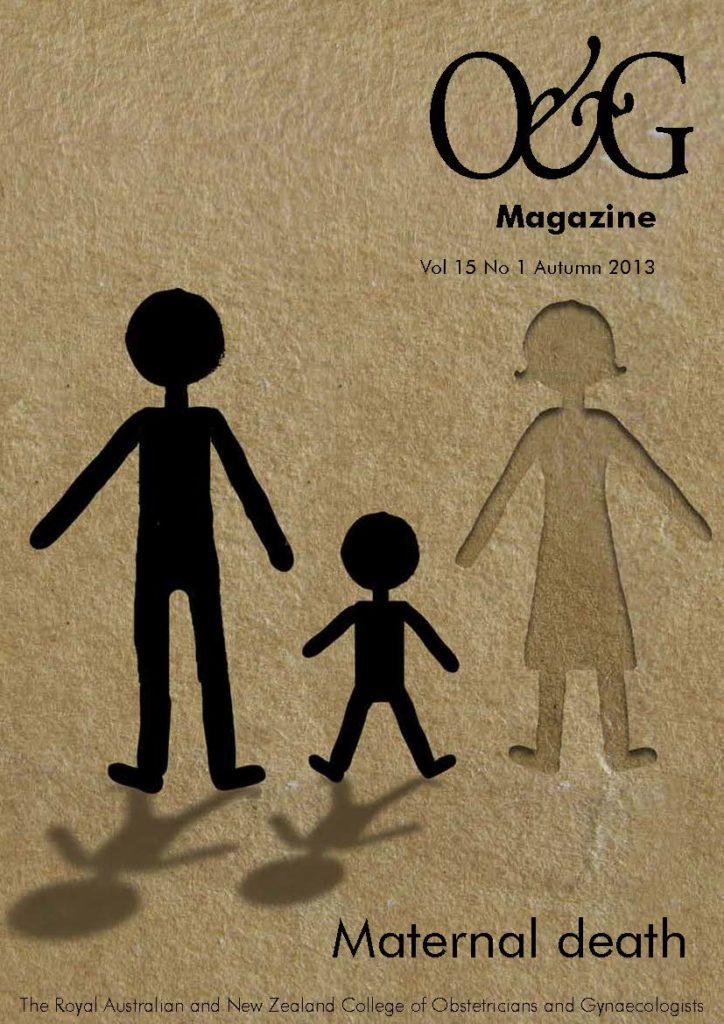Recent data show that cases of maternal sepsis are increasing. Heightened awareness and rapid action will save lives.
Since their inception in the 1920s, the UK Confidential Enquiries into Maternal Deaths have provided useful information and reflection on why mothers die and what we can do to prevent it. The most recent report, published in 2011, contains some old enemies, such as eclampsia and thromboembolism, but of concern is that maternal sepsis seems to be making a reappearance.1 Australian figures place sepsis sixth in the list of direct causes of maternal mortality. Data on maternal deaths from 2003–05, attributed one of 29 cases directly and four of 26 cases indirectly to infection.2 The WHO estimates that puerperal sepsis accounts for 15 per cent of maternal mortality globally.3 In high-income settings, maternal death rates are so low that morbidity data may yield more useful information, such as case-fatality rates for maternal sepsis. Incidence of serious acute maternal morbidity (SAMM) from sepsis in such countries is 0.1–0.6 per 1000 deliveries.4 However, uniformity of definitions, management protocols and data collection across countries and regions are necessary to enable meaningful comparisons.
In 1795, Alexander Gordon’s Treatise on the Epidemic of Puerperal Fever in Aberdeen suggested spread of infection by healthcare workers.5 This was followed by Semelweiss’s seminal work, in 1847, demonstrating a drop in puerperal fever from 18 per cent to 1.27 per cent with simple handwashing.6,7 Since then, antisepsis, infection-control measures, improved socio-economic conditions and antibiotics made death from puerperal fever in high-income countries close to a thing of the past. This most recent report, however, indicates an increase in maternal deaths owing to sepsis and, in particular, a resurgence of beta haemolytic Group A streptococcus (GAS) as a cause. In the report, several organisms were identified and many infections were polymicrobial, but GAS was responsible for 13 of the 29 deaths described, followed by E.coli and Staphylococcus aureus. Deaths occurred from early pregnancy through to the postnatal period. Most of those affected by GAS had complained of an antecedent upper respiratory tract infection and/or had contact with young children, and the majority of cases occurred between December and April (winter/early spring in the UK).
Streptococci are gram-positive cocci that are identified by various laboratory tests including microscopy, biochemical tests, growth and haemolysis on blood agar. Many species pathogenic for humans, including Streptococcus pyogenes, show a zone of complete lysis of blood surrounding their colonies (beta haemolysis) on blood agar. In 1933, Rebecca Lancefield published her method of differentiating beta-haemolytic streptococci into different serogroups, based on group-specific cell wall (carbohydrate) antigens; this is the basis of the serogrouping system still in use. Strains of GAS are further classified on the basis of a cell surface molecule, the M protein, a major virulence factor of GAS that displays a variety of properties including antiphagocytic activity. Type-specific acquired immunity to streptococcal infection is based on the development of opsonising antibodies to the antiphagocytic moiety of the M protein. Serotyping of strains based on antigenic differences between M proteins yields many different M types, although more precise information is provided by nucleotide sequence data of the emm gene that encodes the M protein. Our understanding of this important protein has recently been described as ‘fragmented’ and more detailed study of the full-length of M proteins from different isolates is required to help understand pathogenesis of GAS infections and sequelae (such as rheumatic fever), and to enhance vaccine development.15
S.pyogenes (GAS) is a pathogen specific to humans, being found mainly on the skin or in the throat, but also occasionally isolated from the female genital tract and rectum. It causes a range of different infections from impetigo and sore throat through to toxic shock syndrome and necrotising fasciitis.4 With respect to GAS and maternal sepsis, a prospective study in North America of postpartum invasive streptococcal infections, conducted between 1995 and 2000, showed bacteraemia with no clearly identified focus of infection and endometritis to be the most common presentations, with peritonitis, toxic shock and necrotising fasciitis individually occurring in less than ten per cent of cases.8
For unwary practitioners and patients, typical symptoms and signs of sepsis may be lacking and clinical suspicion may be all that directs the attending clinician. Intrinsic physiological changes of pregnancy (for example, hyperdynamic circulation and changes in peripheral vascular resistance) may cloud interpretation of clinical and laboratory findings. An apparently minor skin and soft tissue infection, including post-operative wound infection, with pain out of proportion to the clinical appearance should be regarded as necrotising fasciitis until proven otherwise. Seemingly mild gastrointestinal symptoms may be due to sepsis. Feeling generally unwell with no localising signs, hypothermia, agitation and confusion and low peripheral white blood cell count may all herald sepsis. Persistent tachycardia and tachypnoea and/or a raised C-reactive protein should suggest sepsis as a possible diagnosis.
For most patients, the first interaction is likely to be with a midwife, general practitioner, emergency department doctor or other health professional who may never have seen a case of maternal sepsis owing to GAS. Failure to recognise the possibility of serious maternal sepsis and implement appropriate investigations and early empiric antibiotic treatment increases the risk of death. There is a point in sepsis beyond which antimicrobial treatment cannot prevent death, owing to a variety of factors such as, inter alia, exotoxins produced by GAS, an exaggerated host immune response, cytokine activation and haemodynamic decompensation. Some of the documented cases illustrate the alarming speed with which GAS sepsis can take hold and inexorably progress to death. Some GAS strains possess particular M proteins that are associated with greater virulence than others; for example, M28, which has been blamed for a resurgence of severe GAS-associated puerperal sepsis.4
The Surviving Sepsis Campaign guidelines are endorsed by the Royal College of Obstetricians and Gynaecologists and adherence to them can optimise outcomes.9,10 Key features include obtaining swabs (of wounds, perineum and throat), urine and blood cultures promptly and commencing broad-spectrum antibiotics within an hour of the diagnosis of septic shock. Blood cultures should be collected even if fever is not present. Prompt and adequate resuscitation with volume replacement and inotropes or vasopressors, where needed, should be instituted. Pregnant women are vulnerable to fluid overload, so support from an intensive care unit should be considered at an early stage. Teamwork is essential, with involvement of experts from key disciplines. Early consultation with a clinical microbiologist or infectious diseases physician is also recommended. Although GAS remains susceptible to penicillin, the preferred antibiotic is intravenous clindamycin (600–1200mg every six or eight hours) as it inhibits GAS exotoxin production and is immunomodulatory.11 Because the possibility of gram-negative septicaemia may be difficult to exclude clinically, empiric therapy often involves using clindamycin in combination with agents such as piperacillin-tazobactam (or ticarcillin-clavulanate) and metronidazole. These should be modified based on clinical progress and the microbiology results.
Although trials have been small, there is some evidence of benefit from use of intravenous immune globulin (IVIg) for toxic shock and necrotising fasciitis, especially that owing to GAS, and for septic shock in general.12,13 A recent Cochrane Review concluded: ‘Polyclonal IVIg reduced mortality among adults with sepsis, but this benefit was not seen in trials with low risk of bias….Most of the trials were small and the totality of evidence is insufficient to support a robust conclusion of benefit.’14 Despite this, and although supplies are limited and expensive, in patients severely ill with GAS-associated toxic shock and necrotising fasciitis, early consideration of IVIg use is advisable.
Timely surgical intervention is essential in the management of necrotising fasciitis. Surgical involvement may also be warranted as antibiotic therapy alone is not adequate if a focus of infection persists (for example, retained products of conception). Timing of surgery can obviously be problematic, but in a severely ill patient, high operative risk may be acceptable when balanced against the need for likely life-saving surgery.1 Unfortunately, even with rapid response by an expert team, deaths will still occur, as was noted in the UK report.
New laboratory methods can assist investigation of clusters of infection. Pulsed-field gel electrophoresis and rapid amplified polymorphic DNA analysis have been used to determine whether a particular M type is the cause of a cluster of infections. Investigation of a cluster of GAS infections in a puerperal sepsis cluster in 2010, in NSW, by whole-genome sequencing permitted finer epidemiological discrimination of closely related strains (in this case M28 strains).15
Preventative measures can also be undertaken. Antiseptic practice and infection control measures are common sense, but should be reinforced. Education of mothers regarding personal hygiene, to avoid colonisation of the perineum with GAS and other bacteria, can prevent infection. Caesarean section, particularly as an emergency procedure, confers a five- to 20-fold risk of developing sepsis.7 Use of prophylactic antibiotics, in both elective and emergency caesarean section, has been shown to reduce the incidence of endometritis by two-thirds to three-quarters and also causes a reduction in wound infection. The effects on the baby are unknown, but there is clear benefit to the mother.16
Maternal deaths owing to GAS infection will continue to occur. Education and training of frontline staff to recognise this rare, but potentially rapidly fatal, infection is important because, with early recognition, consultation, appropriate management and teamwork, morbidity and mortality can be kept to a minimum.
References
- Centre for Maternal and Child Enquiries (CMACE). Saving Mothers’ Lives: Reviewing maternal deaths to make motherhood safer: 2006- 2008. The Eighth Report on Confidential Enquiries into Maternal Deaths in the United Kingdom. BJOG. 2011;118(Suppl. 1):1-203.
- Sullivan E, Hall, B. & King, JF. Maternal deaths in Australia 2003- 2005. Maternal deaths series no. 3. Cat no. PER 42. Sydney: AIHW National Perinatal Statistics Unit. 2007.
- Dolea C, Stein C. Global Burden of Disease 2000. http://www.who. int/healthinfo/statistics/bod_maternalsepsis.pdf.
- van Dillen J, Zwart J, Schutte J, van Roosmalen J. Maternal sepsis: epidemiology, etiology and outcome. Current Opinion in Infectious Diseases. 2010(23):249-254.
- Gordon A. A treatise on the epidemic puerperal fever of Aberdeen. London: GG and J Robinson; 1795.
- Gould I. Alexander Gordon, puerperal sepsis, and modern theories of infection control – Semelweiss in perspective. Lancet Infet Dis 2010;10:275-278.
- Lucas D.N, Robinson P.N, Nel M.R. Sepsis in obstetrics and the role of the anaesthetist. International Journal of Obstetric Anaesthesia. 2012(21):56-67.
- Chuang I, van Beneden C, Beall B, Schuchat A. Population-based surveillance for postpartum invasive group A streptococcus infections, 1995-2000. Clin Infect Dis. 2002(35):665-670.
- Levy MM, Dellinger RP, Townsend SR, et al. The Surviving Sepsis Campaign: results of an international guidelines-based performance improvement program targeting severe sepsis. Intensive Care Med. 2010(36):222-231.
- Dellinger RP, Levy MM, Rhodes A, et al. Surviving Sepsis Campaign: International Guidelines for Management of Severe Sepsis and Septic Shock: 2012. Crit Care Med. February 2013 2013;41(2):580-637.
- Morgan, MS. Diagnosis and Management of Necrotising Fasciitis: a multiparametric approach. J Hospital Infect. 2010(75):249-257.
- Stevens DL. Dilemmas in the Treatment of Invasive Streptococcus Pyogenes Infections. Clin Infect Dis. 1 August 2003(37):341-343.
- Darenberg J, Ihendyane N, Sjolin J, Aufwerber E, Haidl S, Follin P, Andersson J, Norrby-Tegland A, Streptlg Study Group. Intravenous Immunoglobulin G Therapy in Streptococcal Toxic Shock Syndrome: A European Randomized, Double-Blind, Placebo-Controlled Trial. Clinical Infectious Diseases. 1 August 2003(37):333-340.
- Alejandria MM, Lansang MAD, Dans DF, Mantaring III JB. Intravenous Immunoglobulin for treating sepsis, severe sepsis and septic shock. Cochrane Database of Systemic Reviews. 2010(1); CD001090.
- Ben Zakour NL, Venturini C, Beatson SA, Walker MJ. Analysis of a Streptococcus Pyogenes Puerperal Sepsis Cluster by Use of Whole- Genome Sequencing. J. Clin. Microbiol 2012;50(7):2224-2228.
- Smaill FM, Gyte GML. Antibiotic prophylaxis versus no prophylaxis for preventing infection after cesarian section. Cochrane Database of Systemic Reviews. 2010(1);CD007482.






Leave a Reply